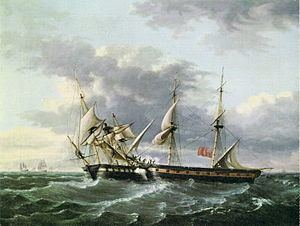Captured 1812 (and recaptured) Launched 9 February 1806 | Tons burthen 384 bm | |
 | ||
Fate Broken up November 1813 Length 100 ft (30.5 m) (overall)77 ft 3 ⁄2 in (23.6 m) (keel) | ||
HMS Frolic was an 18-gun Cruizer-class brig-sloop of the Royal Navy. She was built by Boole, of Bridport and was launched on 9 February 1806. Although she took part in the capture of Martinique, Guadaloupe, and Saint Martin, she appears to have had an uneventful career until 8 October 1812, when the American sloop-of-war USS Wasp captured her after a fierce fight. Later that day the British recaptured Frolic and captured Wasp. Frolic was broken up in 1813.
Contents
Career
On 26 October 1807, Tsar Alexander I of Russia declared war on Great Britain. The official news did not arrive there until 2 December, at which time the British declared an embargo on all Russian vessels in British ports. Frolic was one of some 70 vessels that shared in the seizure of the 44-gun Russian frigate Speshnoy (Speshnyy), then in Portsmouth harbour. The British seized the Russian storeship Wilhelmina (Vilghemina) at the same time. The Russian vessels were carrying the payroll for Vice-Admiral Dmitry Senyavin’s squadron in the Mediterranean.
Frolic, under Commander Thomas Whinyates, sailed for the West Indies on 21 February 1808. There she participated in the Invasion of Martinique in February 1809, and then in the invasion of Guadeloupe. In 1847 the Admiralty authorized the issuance of the Naval General Service Medal with clasps "Martinique" and "Guadaloupe".
On 17 February 1810 Frolic, Surinam, and Superieure joined Captain William Charles Fahie of Abercrombie and his force at the surrender of Saint Martin.
On 14 June 1810, Frolic and Freya (or Freija) arrived at Sombrero Island in the West Indies. The Admiralty had sent them there to assess separately and independently the survival prospects for someone landed at this place without food and water. Captain Warwick Lake of Recruit had marooned an impressed seaman, Robert Jeffrey, there on 13 December 1807, and was now the subject of an Admiralty investigation. They reported back that survival prospects were poor. As it turned out, Jeffrey was alive, a passing American vessel having rescued him. Still, a court-martial dismissed Lake from the Royal Navy.
Frolic vs. Wasp
In October 1812 the Frolic was serving on the North American station, protecting a convoy of six merchantmen off Virginia. On a passage from the Bay of Honduras, a gale dispersed the convoy and carried away Frolic's main top yard and sprung her main top mast.
On 18 October, while the convoy was reassembling and Frolic was working on the damage, a strange sail was spotted. Frolic sent the convoy on its way and hoisted a Spanish ensign as a ruse to buy time.
The strange sail turned out to be USS Wasp, of 18 guns, commanded by Jacob Jones. The ships closed. Initially Frolic fired more rapidly but less accurately, but the gale damage had rendered her unmanageable. Within 40 minutes Wasp had repeatedly raked Frolic, killing 15 and wounding 43 out of the 120 seamen and boys aboard, including Whinyates. The Americans boarded Frolic and all resistance stopped. The Americans had 5 killed and 5 wounded.
Frolic was only temporarily in American hands. Later that day the British 74-gun Poictiers captured both ships. Captain John Poo Beresford of Poictiers restored Whinyates to command of Frolic. The subsequent court martial for the loss of the ship honorably acquitted Whinyates, his officers and his men.
Fate
Frolic was recommissioned later in October under Lieutenant Andrew Mitchell (acting). His commission as commander was confirmed on 24 August 1813. earlier, on 20 July 1813, Frolic was one of four British vessels sharing in the capture of the American ship Fame.
Frolic continued in service until being broken up at Portsmouth in November 1813.
